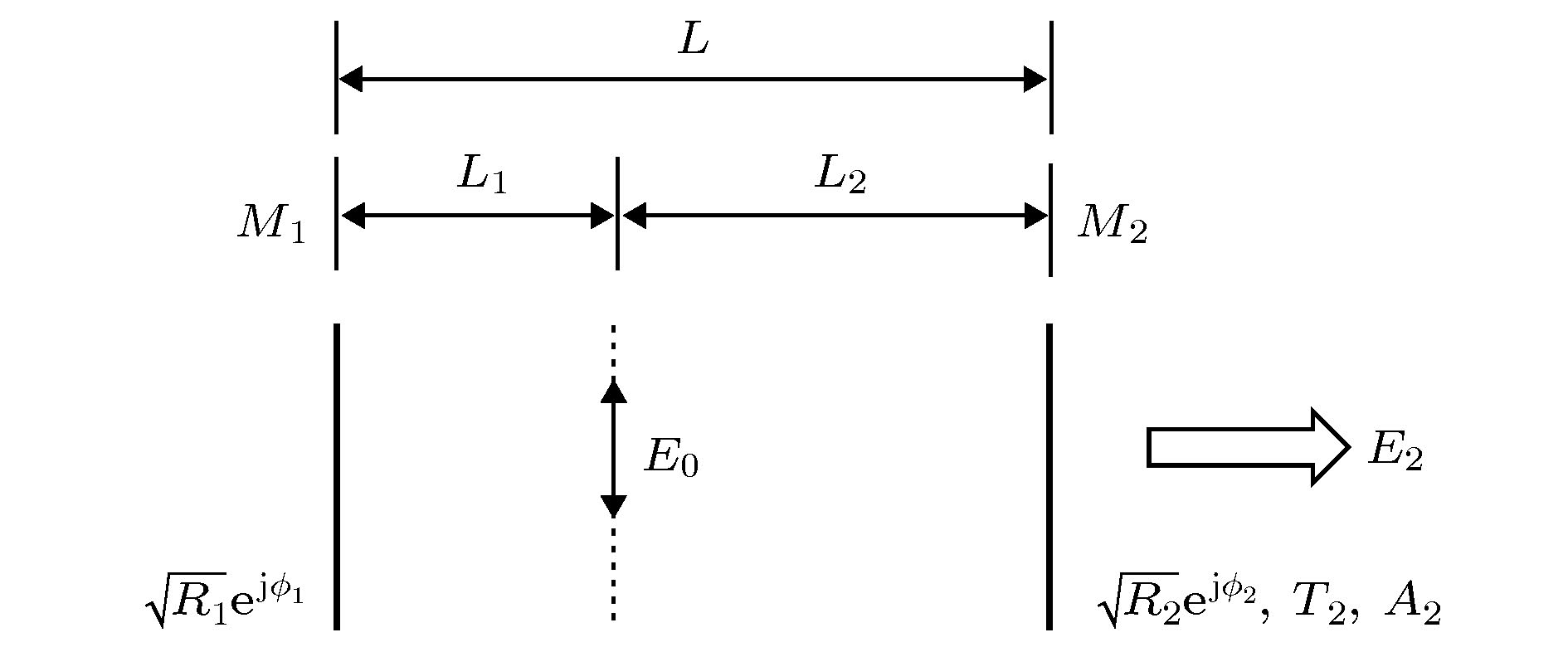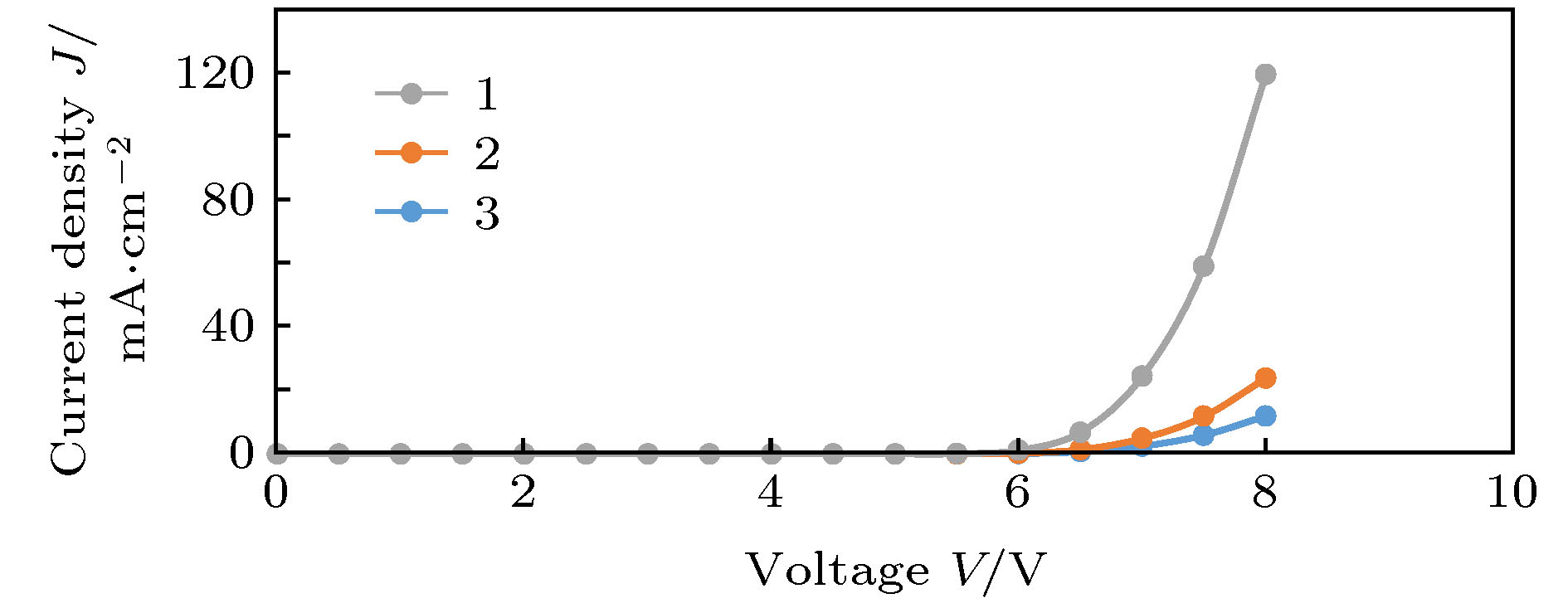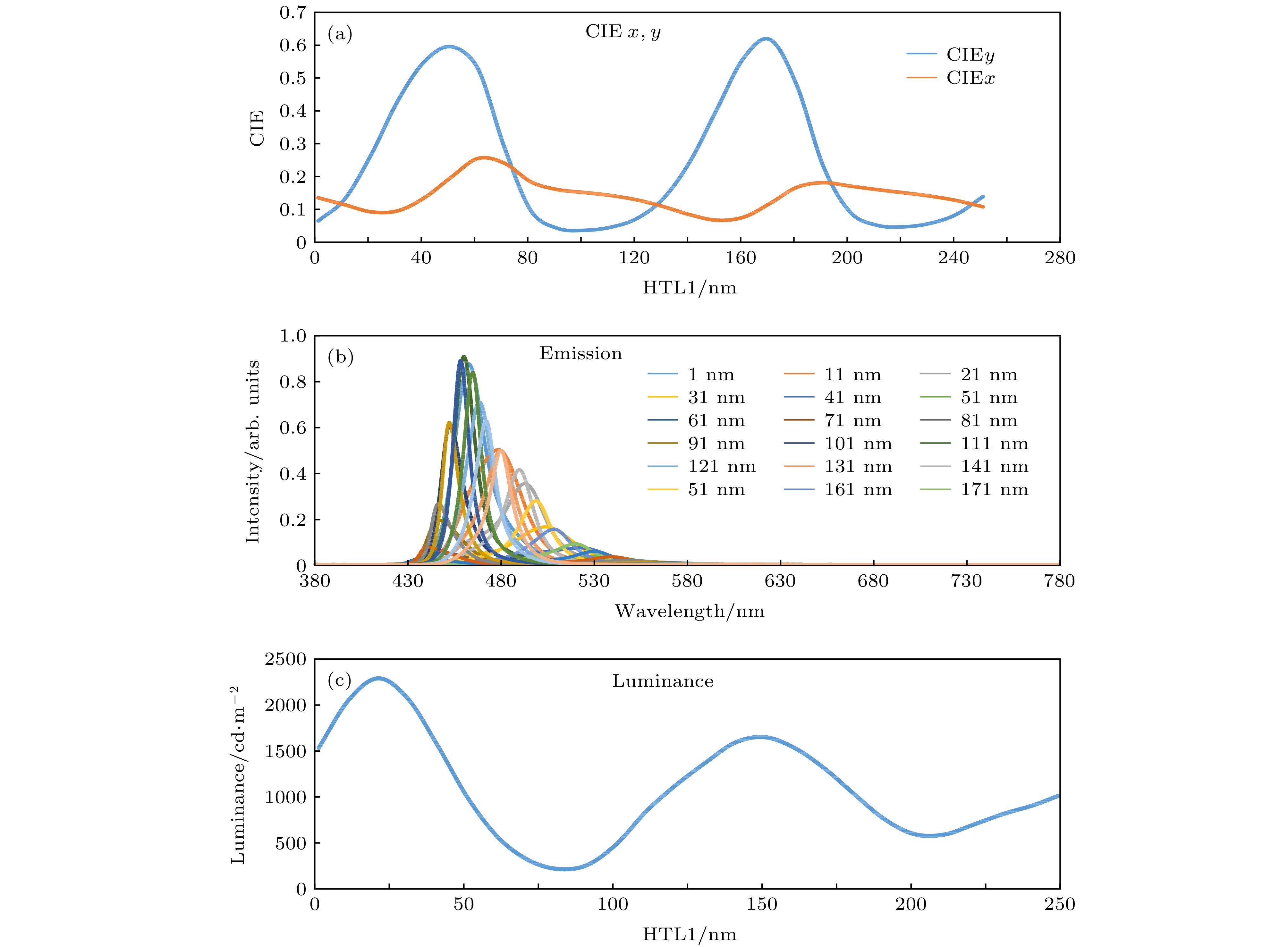-
相比于传统有机电致发光器件, 串联有机电致发光器件的发光效率与寿命均得到明显提升. 因此, 深入研究微腔效应对顶发射串联有机电致发光器件性能的影响具有重要意义. 本文以蓝光器件为例, 通过光学仿真模拟与实际实验相结合的方法, 研究了顶发射串联蓝光器件的光学性能与电学性能变化规律. 具体实验为: 分别制备了顶发射串联蓝光器件, 使其两个发光层位置分别位于器件光学结构中的第一与第二反节点、第二与第三反节点、第三与第四反节点. 分析并确定了顶发射串联蓝光器件的两个发光层位置分别位于第二反节点与第三反节点处时, 器件性能较佳. 即: 当器件电流密度为15 mA/cm2时, 器件电流效率为10.68 cd/A (色坐标CIEx, y = 0.14, 0.05), 其亮度衰减到95%所需时间为1091.55 h. 可能原因是: 器件腔长较长时, 既可以改善第一发光单元的空穴与电子平衡度、削弱表面等离激元效应, 降低膜厚波动性对器件腔长的影响性; 又可以在一定程度内起到包裹Partical的作用, 提高效率, 延长寿命. 这一研究成果为设计高效率、长寿命的顶发射串联器件提供了重要依据.
-
关键词:
- 光学设计 /
- 串联有机电致发光器件 /
- 电流效率 /
- 寿命
Comparing with traditional single organic light-emitting device (OLED), the luminance efficiency and lifetime of tandem OLED are significantly improved. Therefore, it is of crucial importance to in depth study the influence of microcavity effect on the performance of top emitting tandem OLED. In this paper, taking the blue organic light emitting device for example, the change rule of optical and electrical properties of top-emitting tandem blue-light device are studied by combining optical simulation with practical experiments. The specific experiment is as follows. The top emitting tandem blue organic light devices are fabricated, in which the two light-emitting layers are located at the first anti node and second anti node, the second anti node and third anti node, and the third anti node and fourth anti node in the optical structure of the device respectively. It is found that the performance of the device is better when the two emitting layers of the top-emitting tandem blue light device are located at the second anti node and third anti node in the optical structure of the device respectively. That is to say, when the current density of the device is 15 mA/cm2, the current efficiency of the device reaches 10.68 cd/A, color coordinate (CIEx, y) of the device is (0.14, 0.05), and the time of the brightness decreases from 100% to 95% in 1091.55 hours, which is likely to be due to the fact that when the cavity length of the device is long, it can not only improve the recombination rate of hole and electron in the first light-emitting unit, weaken the surface plasmon polarition effect, reduce the influence of the fluctuation of the film thickness on the cavity length of the device, but also play a role of wrapping partials to a certain extent, improve the efficiency and prolong the device lifetime. The research results provide an important theoretical and data basis for designing the top-emitting tandem blue light device with high efficiency and long lifetime. In the future, we will continue to systematically and detailedly study the top emitting tandem organic light-emitting devices, which will provide strong support for preparing the laminated devices with high efficiency long-lifetime, and lower cost.-
Keywords:
- optical design /
- tandem nlue organic light emitting devices /
- current efficiency /
- lifetime
[1] 刘洋 2017 硕士学位论文 (天津: 天津理工大学)
Liu Y 2017 M. S. Thesis (Tianjin: Tianjin University of Technology) (in Chinese)
[2] Sun H D, Chen Y H, Chen J SH, Ma D G 2016 IEEE J. Sel. Top. Quant. Electron. 22 1
 Google Scholar
Google Scholar
[3] 景姝, 王华, 刘慧慧, 杜晓刚, 苗艳勤, 潘成龙, 周禾丰 2014 液晶与显示 29 6
 Google Scholar
Google Scholar
Jing S, Wang H, Liu H H, Du X G, Miao Y Q, Pan C L, Zhou H F 2014 Chin. J. Liq. Cryst. Displays 29 6
 Google Scholar
Google Scholar
[4] Lee H W, Lee J W, Lee S E, Lee J H, Kim Y K 2017 J. Lumin. 188 112
 Google Scholar
Google Scholar
[5] Hong K, Lee J L 2011 Electron. Mater. Lett. 7 77
 Google Scholar
Google Scholar
[6] Hoang V, Lee S E, Lee J G, Kim Y K, Lee J H 2017 Opt. Express 25 31006
 Google Scholar
Google Scholar
[7] Lee S E, Lee H W, Lee J W, Hwang K M, Park S N, Yoon S S, Kim Y K 2015 Jpn. J. Appl. Phys. 54 06F
 Google Scholar
Google Scholar
[8] Sun J X, Zhu X L, Peng H J, Wong M, Kwok H S 2005 Appl. Phys. Lett. 87 093504
 Google Scholar
Google Scholar
[9] Chen C W, Lu Y J, Wu C C, Wu E H E, Chu C W, Yang Y 2005 Appl. Phys. Lett. 87 241121
 Google Scholar
Google Scholar
[10] Kuehne A J C, Gather M C 2016 Chem. Rev. 116 12823
 Google Scholar
Google Scholar
[11] Zhang X, Dong H, Hu W 2018 Adv. Mater. 30 1801048
 Google Scholar
Google Scholar
[12] Muccini M 2006 Nat. Mater. 5 605
 Google Scholar
Google Scholar
[13] Uoyama C, Gou S K, Shi Z K, Nomura H, Adachi C 2012 Nature 492 234
 Google Scholar
Google Scholar
[14] Chen Y, Tian H, Chen Y, Geng Y, Yan D, Wang L, Ma D 2012 J. Mater. Chem. 22 8492
 Google Scholar
Google Scholar
[15] Ban X, Sun K, Sun Y, Huang B, Ye S, Yang M, Jiang W 2015 ACS Appl. Mater. Interfaces 7 25129
 Google Scholar
Google Scholar
[16] Hsu S F, Lee C C, Hu A T, Chen C H 2004 Curr. Appl. Phys. 4 663
 Google Scholar
Google Scholar
[17] Liao L S, Klubek K P, Tang C W 2004 Appl. Phys. Lett. 84 167
 Google Scholar
Google Scholar
[18] Tsutsui T, Terai M 2004 Appl. Phys. Lett. 84 440
 Google Scholar
Google Scholar
[19] Yang J P, Bao Q Y, Xiao Y, Deng Y H, Li Y Q, Lee S T, Tang J X 2012 Org. Electron. 13 2243
 Google Scholar
Google Scholar
[20] Ho M H, Chen T M, Yeh P C, Hwang S W, Chen C H 2007 Appl. Phys. Lett. 91 233507
 Google Scholar
Google Scholar
[21] 张娟 2017 硕士学位论文 (天津: 天津理工大学)
Zhang J 2017 M. S. Thesis (Tianjin: Tianjin University of Technology) (in Chinese)
[22] Zhang J, Xin L W, Gao J, Liu Y, Rui H S, Lin X, Hua Y L, Wu X M, Yin S G 2017 J. Mater. Sci. Mater. Electron. 28 12761
 Google Scholar
Google Scholar
[23] 李亭亭 2018 硕士学位论文 (西安: 陕西科技大学)
Li T T 2018 M.S. Thesis (Shaanxi: Shaanxi University of Science & Technology) (in Chinese)
[24] Udagawa K, Sasabe H, Cai C, Kido J 2014 Adv. Mater. 26 5062
 Google Scholar
Google Scholar
-
图 4 器件A1发光性能模拟图 (a)不同的腔长对OLED器件CIEx, y的影响; (b)不同的腔长对OLED器件发光光谱的影响; (c)不同的腔长对OLED器件亮度的影响
Fig. 4. Simulated electroluminescence (EL) performance of devices A1: (a) Influence of length of microcavity on CIEx, y of OLED; (b) influence of length of microcavity on spectrum of OLED; (c) influence of length of microcavity on luminance of OLED.
图 5 器件A2发光性能模拟图 (a)不同的腔长对OLED器件CIEx, y的影响; (b)不同的腔长对OLED器件发光光谱的影响; (c)不同的腔长对OLED器件亮度的影响
Fig. 5. Simulated EL performance of devices A2: (a) Influence of length of microcavity on CIEx, y of OLED; (b) influence of length of microcavity on spectrum of OLED; (c) influence of length of microcavity on luminance of OLED.
图 10 器件B, C, D, E的发光性能图 (a)光谱特性曲线; (b)电流效率-亮度特性曲线; (c)电流密度-功率效率特性曲线; (d)电流密度-外量子效率特性曲线; (e)电流密度-电压特性曲线; (f)寿命特性曲线@50 mA/cm2; (g)寿命特性曲线@15 mA/cm2; (h)亮度-视角特性曲线; (i)光谱-视角特性曲线
Fig. 10. The EL performance of devices B, C, D and E: (a) The spectrum characteristics; (b) the current efficiency-luminance characteristics; (c) the current density-power efficiency characteristics; (d) the current density- external quantum efficiency characteristics; (e) the current density-voltage characteristics; (f) the lifetime characteristics @50 mA/cm2; (g) the lifetime characteristics @15 mA/cm2; (h) the luminance-angle characteristics; (i) the spectrum-angle characteristics.
图 12 器件G发光性能模拟图 (a)不同的腔长对OLED器件CIEx, y的影响; (b)不同的腔长对OLED器件发光光谱的影响; (c)不同的腔长对OLED器件亮度的影响
Fig. 12. Simulated EL performance of devices G: (a) Influence of the length of microcavity on CIEx, y of OLED; (b) influence of the length of microcavity on spectrum of OLED; (c) influence of the length of microcavity on luminance of OLED.
图 13 器件F, H, I, J的发光性能图 (a)光谱特性曲线; (b)电流效率-亮度特性曲线; (c)电流密度-功率效率特性曲线; (d)电流密度-外量子效率特性曲线; (e)电流密度-电压特性曲线; (f)寿命特性曲线@50 mA/cm2
Fig. 13. The EL performance of devices F, H, I and J: (a) The spectrum characteristics; (b) the current efficiency-luminance characteristics; (c) the current density-power efficiency characteristics; (d) the current density-external quantum efficiency characteristics; (e) the current density-voltage characteristics; (f) the lifetime characteristics @50 mA/cm2.
表 1 有机材料的折射率
Table 1. Refractive index of organic materials.
波长/nm 折射率 HAT-CN NPB TCTA ADN DAS-ph TPBi Liq 465 2.02 2.05 1.96 2.09 1.96 1.70 1.85 545 1.92 1.94 1.88 1.89 1.88 1.66 1.79 620 1.88 1.89 1.85 1.83 1.85 1.64 1.76 表 2 器件A的测试性能参数
Table 2. Performance parameters of device A.
Device@15 mA/cm2 V/V L/cd·m–2 CE/cd·A–1 PE/lm·W–1 EQE/% CIEx CIEy 5 nm 6.76 1548 10.32 4.78 5.25 0.1372 0.0516 25 nm 7.11 1425 9.51 4.26 4.88 0.3463 0.4545 45 nm 7.42 1380 9.22 3.90 4.69 0.3425 0.6028 65 nm 8.30 615 4.13 1.61 2.20 0.3621 0.6218 85 nm 8.86 825 5.53 1.96 2.82 0.1375 0.0405 105 nm 9.51 1470 9.82 3.14 4.55 0.1318 0.4528 125 nm 10.21 1603 10.68 3.28 5.25 0.1369 0.0512 145 nm 10.80 1530 10.20 2.96 5.02 0.3326 0.4168 165 nm 11.11 1021 6.80 1.92 4.91 0.3463 0.4545 185 nm 11.32 634 4.23 1.16 2.32 0.3425 0.6028 205 nm 11.66 799 5.32 1.43 2.51 0.1375 0.0405 225 nm 11.98 1534 10.22 2.69 5.12 0.1310 0.4512 245 nm 12.34 1580 10.53 2.66 5.36 0.1369 0.0502 265 nm 12.62 1504 10.03 2.49 5.08 0.3512 0.4555 表 3 器件B, C, D, E的性能参数
Table 3. Performance parameters of devices B, C, D and E.
Device@15 mA/cm2 V/V L/cd·m–2 CE/cd·A–1 PE/lm·W–1 EQE/% CIEx CIEy LT95(h) @50 mA/cm2 B 3.71 978 6.52 5.51 4.08 0.1376 0.0514 58.26 C 6.87 1548 10.32 4.71 6.62 0.1372 0.0516 93.88 D 7.33 1603 10.68 4.58 6.86 0.1369 0.0512 140.65 E 8.12 1579 10.53 4.06 6.77 0.1369 0.0508 79.88 表 4 器件F, H, I, J的性能参数
Table 4. Performance parameters of devices F, H, I and J.
Device@15 mA/cm2 V/V L/cd·m–2 CE/cd·A–1 PE/lm·W–1 EQE/% CIEx CIEy LT95(h) @50 mA/cm2 F 3.90 880 5.87 4.72 3.05 0.1385 0.0504 46.12 H 7.21 1238 8.26 3.59 4.29 0.1383 0.0508 80.88 I 7.72 1683 11.22 4.57 5.86 0.1379 0.0511 93.21 J 8.31 1547 10.32 3.91 5.35 0.1378 0.0515 72.36 -
[1] 刘洋 2017 硕士学位论文 (天津: 天津理工大学)
Liu Y 2017 M. S. Thesis (Tianjin: Tianjin University of Technology) (in Chinese)
[2] Sun H D, Chen Y H, Chen J SH, Ma D G 2016 IEEE J. Sel. Top. Quant. Electron. 22 1
 Google Scholar
Google Scholar
[3] 景姝, 王华, 刘慧慧, 杜晓刚, 苗艳勤, 潘成龙, 周禾丰 2014 液晶与显示 29 6
 Google Scholar
Google Scholar
Jing S, Wang H, Liu H H, Du X G, Miao Y Q, Pan C L, Zhou H F 2014 Chin. J. Liq. Cryst. Displays 29 6
 Google Scholar
Google Scholar
[4] Lee H W, Lee J W, Lee S E, Lee J H, Kim Y K 2017 J. Lumin. 188 112
 Google Scholar
Google Scholar
[5] Hong K, Lee J L 2011 Electron. Mater. Lett. 7 77
 Google Scholar
Google Scholar
[6] Hoang V, Lee S E, Lee J G, Kim Y K, Lee J H 2017 Opt. Express 25 31006
 Google Scholar
Google Scholar
[7] Lee S E, Lee H W, Lee J W, Hwang K M, Park S N, Yoon S S, Kim Y K 2015 Jpn. J. Appl. Phys. 54 06F
 Google Scholar
Google Scholar
[8] Sun J X, Zhu X L, Peng H J, Wong M, Kwok H S 2005 Appl. Phys. Lett. 87 093504
 Google Scholar
Google Scholar
[9] Chen C W, Lu Y J, Wu C C, Wu E H E, Chu C W, Yang Y 2005 Appl. Phys. Lett. 87 241121
 Google Scholar
Google Scholar
[10] Kuehne A J C, Gather M C 2016 Chem. Rev. 116 12823
 Google Scholar
Google Scholar
[11] Zhang X, Dong H, Hu W 2018 Adv. Mater. 30 1801048
 Google Scholar
Google Scholar
[12] Muccini M 2006 Nat. Mater. 5 605
 Google Scholar
Google Scholar
[13] Uoyama C, Gou S K, Shi Z K, Nomura H, Adachi C 2012 Nature 492 234
 Google Scholar
Google Scholar
[14] Chen Y, Tian H, Chen Y, Geng Y, Yan D, Wang L, Ma D 2012 J. Mater. Chem. 22 8492
 Google Scholar
Google Scholar
[15] Ban X, Sun K, Sun Y, Huang B, Ye S, Yang M, Jiang W 2015 ACS Appl. Mater. Interfaces 7 25129
 Google Scholar
Google Scholar
[16] Hsu S F, Lee C C, Hu A T, Chen C H 2004 Curr. Appl. Phys. 4 663
 Google Scholar
Google Scholar
[17] Liao L S, Klubek K P, Tang C W 2004 Appl. Phys. Lett. 84 167
 Google Scholar
Google Scholar
[18] Tsutsui T, Terai M 2004 Appl. Phys. Lett. 84 440
 Google Scholar
Google Scholar
[19] Yang J P, Bao Q Y, Xiao Y, Deng Y H, Li Y Q, Lee S T, Tang J X 2012 Org. Electron. 13 2243
 Google Scholar
Google Scholar
[20] Ho M H, Chen T M, Yeh P C, Hwang S W, Chen C H 2007 Appl. Phys. Lett. 91 233507
 Google Scholar
Google Scholar
[21] 张娟 2017 硕士学位论文 (天津: 天津理工大学)
Zhang J 2017 M. S. Thesis (Tianjin: Tianjin University of Technology) (in Chinese)
[22] Zhang J, Xin L W, Gao J, Liu Y, Rui H S, Lin X, Hua Y L, Wu X M, Yin S G 2017 J. Mater. Sci. Mater. Electron. 28 12761
 Google Scholar
Google Scholar
[23] 李亭亭 2018 硕士学位论文 (西安: 陕西科技大学)
Li T T 2018 M.S. Thesis (Shaanxi: Shaanxi University of Science & Technology) (in Chinese)
[24] Udagawa K, Sasabe H, Cai C, Kido J 2014 Adv. Mater. 26 5062
 Google Scholar
Google Scholar
计量
- 文章访问数: 11994
- PDF下载量: 295
- 被引次数: 0














 下载:
下载:












